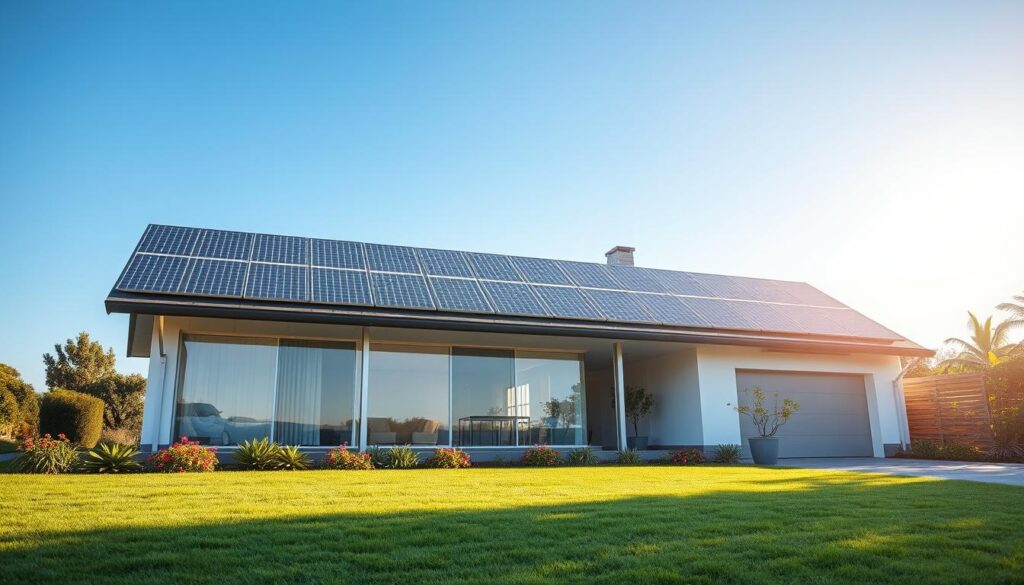Switching to solar energy is a smart move for both your wallet and the planet. At Home of Solar, we make this transition seamless and rewarding. Our expert team guides you every step of the way, ensuring you get the most out of your solar panel system.
Modern solar panels are highly efficient, converting up to 22% of the sun’s energy into electricity. This means you can power your entire house while reducing your carbon footprint. Plus, with competitive pricing from top manufacturers like ZNshine Solar and Qcells, going solar has never been more affordable.
Our company specializes in customized solutions tailored to your needs. Whether you’re looking to cut down on energy bills or increase your property value, we’ve got you covered. With minimal maintenance and long-term savings, a solar energy system is a wise investment for any homeowner.
Ready to explore the benefits? Our comprehensive Buyer’s Guide simplifies the process, making it easy to understand and affordable. Let’s work together to harness the sun’s power and create a brighter, greener future.
Key Takeaways
- Switching to solar energy saves money and helps the environment.
- Modern solar panels are highly efficient and affordable.
- Customized solutions ensure your system meets your needs.
- Minimal maintenance and long-term savings make solar a smart investment.
- Our Buyer’s Guide simplifies the process of going solar.
Understanding Solar Energy and Its Benefits
Solar energy is transforming how we power our lives. By converting sunlight into electricity, this renewable source offers a sustainable alternative to traditional methods. With advancements in technology, harnessing the sun’s power has become more efficient and accessible than ever.
How Solar Panels Generate Renewable Energy
Solar panels use photovoltaic (PV) cells to capture sunlight and convert it into direct current (DC) electricity. An inverter then transforms this into alternating current (AC), which powers your home. Modern panels, like half-cut cells, boost efficiency by reducing energy loss and increasing output.
Environmental and Financial Advantages
Switching to solar reduces your carbon footprint and improves air quality. Over 25 years, a single system can offset tons of greenhouse gas emissions. Financially, solar lowers your electricity bill and can increase your property value by up to $15,000.
Additionally, incentives like the federal tax credit cover 30% of installation costs. Programs like net metering allow you to earn credits by selling excess power back to the grid. These benefits make solar a smart investment for both your wallet and the planet.
Impact on Your Electric Bill and Utility Savings
Solar systems can cut your electric bill by up to 50%. For example, homeowners in sunny states like California save thousands annually. Even in cloudy regions, panels generate enough power to significantly reduce utility expenses.
With minimal maintenance and long-term savings, solar energy is a reliable way to take control of your energy costs. Start exploring the benefits today and join the millions of households already enjoying the advantages of clean, renewable power.
How Solar Panels Work: Technology and Efficiency
Solar panels are marvels of modern engineering, converting sunlight into usable energy. At the heart of this process lies advanced technology that ensures maximum efficiency and reliability. Understanding how these systems function can help you appreciate their benefits and make informed decisions.

The Science Behind Half-Cut Solar Cells
One of the latest innovations in solar technology is the use of half-cut cells. Traditional solar cells are split into two, reducing energy loss and improving performance, especially in shaded conditions. This design minimizes resistance and increases the overall output of the solar panel.
Half-cut cells also enhance durability by distributing stress more evenly. This makes them ideal for areas with varying weather conditions. By boosting efficiency and longevity, this technology ensures your system delivers consistent results for years.
Key Components: Inverters, Batteries, and Mounting Systems
Inverters play a crucial role in converting the direct current (DC) electricity generated by panels into alternating current (AC) for home use. Modern inverters are highly efficient, ensuring minimal energy loss during the conversion process.
Batteries store excess energy for later use, providing backup power during outages. This is especially useful in areas with unreliable grid access. Proper installation of these components ensures optimal performance and safety.
Mounting systems secure panels in place, whether on rooftops or the ground. They are designed to withstand harsh weather while maximizing exposure to sunlight. A well-installed mounting system can significantly impact the overall efficiency of your solar energy setup.
Performance metrics like kilowatt ratings and sunlight absorption rates are essential for evaluating a system’s output. By understanding these factors, you can choose the right setup to meet your energy needs and maximize savings.
Navigating the Solar Market: Comparing Options and Costs
Choosing the right solar setup can feel overwhelming, but understanding the market makes it easier. With so many manufacturers and designs available, it’s important to compare options to find the best fit for your needs. This ensures you get the most value for your money while maximizing your return on investment.
Evaluating Different Manufacturers and Panel Designs
When comparing solar panels, consider factors like efficiency, durability, and warranty. Top manufacturers like ZNshine Solar and Qcells offer high-quality products with proven performance. For example, half-cut cell designs reduce energy loss and perform better in shaded areas.
Each system has pros and cons. Monocrystalline panels are highly efficient but cost more, while polycrystalline options are budget-friendly but slightly less effective. Your choice depends on your property and energy goals.
Pricing Strategies and Return on Investment
Solar costs vary based on system size, location, and installation complexity. On average, a 11 kW system costs around $20,552 after federal tax credits. This investment can save you up to $31,000 over 25 years.
To calculate ROI, consider factors like energy savings, incentives, and local grid policies. For instance, net metering allows you to earn credits by selling excess power back to the utility company. A detailed quote from a trusted installer helps you understand the full picture.
By comparing options and asking the right questions, you can make an informed decision that benefits both your wallet and the community.
Home of Solar: Why It’s the Right Choice for Homeowners
Homeowners across the country are discovering the benefits of solar energy. With rising electricity costs and a growing focus on sustainability, switching to solar is a smart move. Home of Solar makes this transition seamless, offering expert guidance and tailored solutions for every property.

Expert Guidance from a Trusted Solar Company
At Home of Solar, we pride ourselves on providing unmatched support. Our team of professionals walks you through every step, from initial consultation to installation. Whether you’re new to solar energy or upgrading your system, we ensure you have all the information you need.
Customer testimonials highlight our commitment to reliability and satisfaction. One homeowner shared, “The team made the process so easy. I felt confident in my decision every step of the way.”
Customized Solar Solutions for Every Home
No two properties are the same, and neither are their energy needs. We design solar panel home systems that fit your unique requirements. Whether you’re looking to reduce your electric bill or increase your property value, we’ve got you covered.
Our flexible solar lease options and competitive credit programs make going solar affordable. Plus, we’re proud to support community solar initiatives, helping neighborhoods go green together.
- Expert advice and support throughout the solar adoption process.
- Custom installations tailored to your property’s energy needs.
- Flexible lease options and credit programs for affordability.
- Active involvement in community solar projects.
- Decades of industry experience and trusted reputation.
With Home of Solar, you’re not just investing in clean energy—you’re joining a movement toward a brighter, greener future. Let us help you make the switch today.
Exploring Different Solar Kit Options and Setups
Exploring solar kit options can help homeowners find the perfect fit for their energy needs. With various configurations available, understanding the differences ensures you choose the right solar system for your property. Let’s break down the most common setups and their benefits.
Grid-Tie and Battery Backup Solar Kits
Grid-tie systems connect directly to the utility grid, allowing you to use both solar and traditional power. These kits are cost-effective and require minimal maintenance. With net metering, excess energy is sent back to the grid, earning you credits on your bill.
Adding a battery backup provides power during outages. This option is ideal for areas with unreliable grid access. It ensures your home stays powered even when the grid goes down.
Off-Grid and Ground Mount Systems
Off-grid kits are perfect for remote locations without utility connections. These systems rely on battery storage to provide consistent power. They are self-sufficient and independent of the grid.
Ground mount systems are ideal for properties with limited roof space. They are customizable based on soil type and local requirements. This setup maximizes sunlight exposure for optimal energy production.
Roof Mount and Microinverter Configurations
Roof mount kits are the most common, utilizing existing roof space for panel placement. They are secure and efficient, making them a popular choice for residential properties.
Microinverters enhance performance by converting energy at the panel level. This reduces energy loss and improves overall system efficiency. They are a great option for homes with shading issues.
Each solar system has unique benefits, catering to different energy needs. Whether you’re looking for grid-tie simplicity or off-grid independence, there’s a kit for you. Expert support ensures a smooth installation process, helping you maximize your investment.
Maximizing Your Solar Investment: Incentives and Savings
Investing in solar energy offers significant financial and environmental rewards. By leveraging available incentives, you can reduce upfront costs and maximize long-term savings. Let’s explore how tax credits, utility programs, and personalized tools can make going solar more affordable than ever.

Federal and State Tax Credits Explained
The federal tax credit covers 30% of your solar installation costs. This incentive applies to systems installed between 2022 and 2032. Many states also offer additional credits, such as property tax exemptions and sales tax waivers. These programs significantly lower the initial investment, making solar energy accessible to more households.
Utility Incentives and Net Metering Benefits
Utility companies often provide rebates and net metering programs. With net metering, excess energy sent back to the grid earns you credits on your electric bill. In states like Florida, these credits are equal to the retail rate of electricity, further reducing your monthly expenses. Additionally, some utilities offer cash incentives for installing solar systems, adding to your savings.
Using Solar Calculators for a Personalized Quote
Online tools like Google’s Project Sunroof help estimate your solar potential and savings. By entering your address and energy usage, you can receive a personalized quote. These calculators consider factors like sunlight exposure and local utility rates to provide accurate projections. Consulting with a trusted installer ensures your system is the perfect fit for your needs.
“The federal tax credit and net metering programs made solar an easy decision for us. We’re saving hundreds each year on our energy bills.”
- Federal and state tax credits reduce upfront costs by thousands of dollars.
- Net metering programs allow you to earn credits for excess energy.
- Solar calculators provide personalized estimates to help you plan your investment.
- Industry-leading installers ensure your system is optimized for maximum savings.
- Long-term benefits include lower electric bills and increased property value.
By taking advantage of these incentives, you can make a smart investment that pays off for years. Start exploring your options today and join the growing community solar movement.
Conclusion
Harnessing the sun’s power is a game-changer for both your wallet and the environment. Modern solar panels and advanced technologies like half-cut cells maximize efficiency, reducing your electric bill and carbon footprint. With federal tax credits and utility incentives, the financial benefits are undeniable.
Choosing the right system and a trusted installer ensures optimal performance and long-term savings. Expert guidance simplifies the process, helping you find the perfect fit for your property and energy needs.
Ready to make the switch? Get a personalized quote today and join the growing community benefiting from clean, renewable power. Together, we can create a brighter, greener future.
